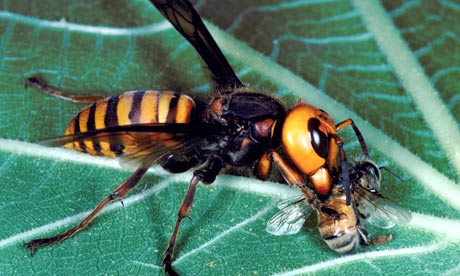
One of the Giant Hornets gobbling a bee. They are as large as an adult human thumb and deliver powerful toxins that can shut down the kidneys and cause other organ failure.
As if the increased weeds, pine beetles, fire ants, 'crazy' ants, and West Nile mosquitoes aren't bad enough, there now appears to be Giant Killer Hornets on the pest horizon. So far, these beasties are confined to China, where they've killed over three dozen the past few months, but with globalized trade etc. it's only a matter of time before a queen or two reaches the States - and then, watch out!
While typical honeybees leave a stinger, which can be pulled out, as I did the other day while weeding, these Chinese fuckers leave major dents in the flesh - I am talking HOLES - which can then incept rotting flesh, otherwise known in medical jargon as "necrotizing fascitis". According to recent accounts, one Chinese villager was stung so badly by the bastards that his liver and kidneys failed, he stopped urinating, and then died in agony.
How can such horrors arise from an insect? Well, Vespa Mandarina isn't an ordinary insect. It's the world's largest hornet, around the size of a human adult's thumb, yellow and black in color and highly venomous. Its 6mm-long (1/4 inch) stingers carry a venom potent enough to dissolve human tissue. Victims may die of kidney failure or anaphylactic shock. Each infliction of the 1/4 inch long stinger into flesh leaves a small hole, as if the bugger had sent its own mini 'bullet' into you. The flesh can start rotting almost immediately if nothing is done. Multiple stings and, well, make sure you have a will.
The critter's spread in China (over the past year) has been attributed to unusually warm weather, allowing a high number of hornets to survive the winter. In this sense, the effect parallels that for the Mountain Pine Beetle in the Western U.S., accounting for immensely larger populations which then infest trees - converting them into tinder and fuel for wild fires. The beetle doesn't sting, but the hornet does. Add to this the migration of laborers deeper into the mountains, disturbing the hornets' nests, and you have a recipe for disaster and lots of human pain. (The workers probably moved to the higher altitudes also to escape hotter temperatures.)
The pests can only be wiped out at night when they aren't flying around. Then, it's all manpower to the battlements. Ankang is on alert, with the local authorities posting warning notices online, on roadside tree trunks and on primary school walls. The crisis has exhausted Gong Zhenghong, the mayor of Hongshan township in rural Ankang. Since September, Gong has spent nearly every night wandering the township exterminating nests. He says there are 248 hornet nests in Hongshan, with 175 close to schools and roads. Gong and his team survey nests by day; once the sun sets, they dress in homemade anti-hornet suits made from rain jackets and canvas, and burn the nests with spray-can flamethrowers.
It's not much consolation that these horror flick -style varmints are still in China. Most of us know, based on past history, how easy it is for an alien species to be accidentally (or intentionally) transported to the U.S., from Burmese pythons in S. Florida, to Asian Carp in the Mississippi River, to the notorious Africanized "killer" bees throughout most of the southern, southwest U.S. So, it may be only a matter of time before the Giant Killer Hornets, native to China, make their way on a ship or even plane cargo, to the U.S.
To see more biological nightmares of climate change, go to:
http://brane-space.blogspot.com/2011/08/biological-nightmares-of-climate-change.html
No comments:
Post a Comment